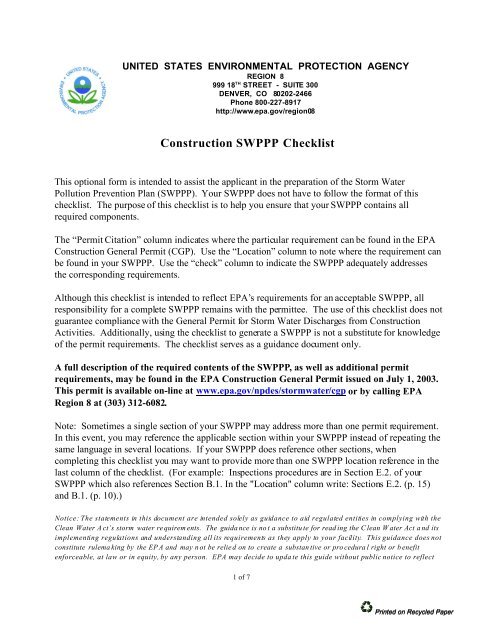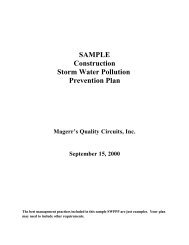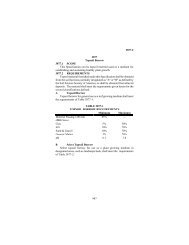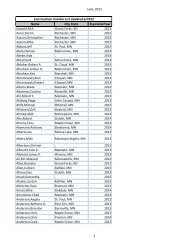Construction SWPPP Checklist - Erosion and Stormwater ...
Construction SWPPP Checklist - Erosion and Stormwater ...
Construction SWPPP Checklist - Erosion and Stormwater ...
Create successful ePaper yourself
Turn your PDF publications into a flip-book with our unique Google optimized e-Paper software.
UNITED STATES ENVIRONMENTAL PROTECTION AGENCY<br />
REGION 8<br />
999 18 TH STREET - SUITE 300<br />
DENVER, CO 80202-2466<br />
Phone 800-227-8917<br />
http://www.epa.gov/region08<br />
<strong>Construction</strong> <strong>SWPPP</strong> <strong>Checklist</strong><br />
This optional form is intended to assist the applicant in the preparation of the Storm Water<br />
Pollution Prevention Plan (<strong>SWPPP</strong>). Your <strong>SWPPP</strong> does not have to follow the format of this<br />
checklist. The purpose of this checklist is to help you ensure that your <strong>SWPPP</strong> contains all<br />
required components.<br />
The “Permit Citation” column indicates where the particular requirement can be found in the EPA<br />
<strong>Construction</strong> General Permit (CGP). Use the “Location” column to note where the requirement can<br />
be found in your <strong>SWPPP</strong>. Use the “check” column to indicate the <strong>SWPPP</strong> adequately addresses<br />
the corresponding requirements.<br />
Although this checklist is intended to reflect EPA’s requirements for an acceptable <strong>SWPPP</strong>, all<br />
responsibility for a complete <strong>SWPPP</strong> remains with the permittee. The use of this checklist does not<br />
guarantee compliance with the General Permit for Storm Water Discharges from <strong>Construction</strong><br />
Activities. Additionally, using the checklist to generate a <strong>SWPPP</strong> is not a substitute for knowledge<br />
of the permit requirements. The checklist serves as a guidance document only.<br />
A full description of the required contents of the <strong>SWPPP</strong>, as well as additional permit<br />
requirements, may be found in the EPA <strong>Construction</strong> General Permit issued on July 1, 2003.<br />
This permit is available on-line at www.epa.gov/npdes/stormwater/cgp or by calling EPA<br />
Region 8 at (303) 312-6082.<br />
Note: Sometimes a single section of your <strong>SWPPP</strong> may address more than one permit requirement.<br />
In this event, you may reference the applicable section within your <strong>SWPPP</strong> instead of repeating the<br />
same language in several locations. If your <strong>SWPPP</strong> does reference other sections, when<br />
completing this checklist you may want to provide more than one <strong>SWPPP</strong> location reference in the<br />
last column of the checklist. (For example: Inspections procedures are in Section E.2. of your<br />
<strong>SWPPP</strong> which also references Section B.1. In the "Location" column write: Sections E.2. (p. 15)<br />
<strong>and</strong> B.1. (p. 10).)<br />
Notice: The statements in this document are intended solely as guidance to aid regulated entities in complying with the<br />
Clean Water A ct’s storm water requirem ents. The guidance is no t a substitute for read ing the C lean W ater Act a nd its<br />
implementing regulations <strong>and</strong> underst<strong>and</strong>ing all its requirements as they apply to your facility. This guidance does not<br />
constitute rulema king by the EPA <strong>and</strong> may n ot be relied on to create a substantive or pro cedura l right or benefit<br />
enforceable, at law or in equity, by any person. EPA may decide to update this guide without public notice to reflect<br />
1 of 7<br />
Printed on Recycled Paper<br />
Printed on Recycled Paper
changes in EPA’s approach to implementing the Clean Water Act. This document reflects information in the latest<br />
EPA NPD ES General Permit for Storm Water Discharges from Large <strong>and</strong> Small <strong>Construction</strong> Activities.<br />
Storm Water Pollution Prevention Plan Elements<br />
Permit<br />
Citation<br />
Part 3.1<br />
Description Location in<br />
<strong>SWPPP</strong> &<br />
Notes<br />
Identify all potential sources of pollution that might affect the<br />
quality of storm water discharges from the site.<br />
Parts 3.2<br />
<strong>and</strong> 3.3 .A<br />
Identify all operators at the site, <strong>and</strong> the areas over which each<br />
operato r has con trol.<br />
Project & Activity Description<br />
Part 3.3.B<br />
Describe the natu re/function of the constru ction pro ject.<br />
3.3.D<br />
Site Map<br />
Describe the intended sequence of major construction activities.<br />
Indicate the total site area (in acres) that is expected to be<br />
disturbed (including off-site borrow & fill areas).<br />
Include a general location map identifying site location <strong>and</strong> any<br />
waters of the U.S. within one mile of the site.<br />
Indicate the location of any storm water discharges associated<br />
with industrial activity other than at the site (e.g., dedicated<br />
asphalt or concrete plants).<br />
Part 3.3.C<br />
Include a legible site map , comp lete to scale, of the en tire site.<br />
Indicate the following items on that map:<br />
Direction of storm water flow/drainage patterns, <strong>and</strong><br />
approximate slopes after m ajor grading activities;<br />
Areas to be disturbed <strong>and</strong> areas that will not be disturbed;<br />
Locations of off-site material, waste, borrow or equipment<br />
storage areas use d solely for the project;<br />
Locations of major structural <strong>and</strong> non-structural erosion <strong>and</strong><br />
sedimentation controls;<br />
Name <strong>and</strong> location of all waters of the U.S., including wetl<strong>and</strong>s;<br />
Locatio ns where storm water discharges to a surface water or to<br />
a municipal storm sewer system; <strong>and</strong><br />
2 of 7
Areas where final stabilization has occurred <strong>and</strong> no further<br />
construction will be done.<br />
Permit<br />
Citation<br />
Controls to Reduce Pollutants<br />
Description Location in<br />
<strong>SWPPP</strong> &<br />
Notes<br />
Part 3.4.A<br />
Part 3.4.B<br />
Part 3.4.C<br />
Part 3.4.D<br />
Part 3.4.E<br />
Part 3.4.F<br />
Part 3.4.G<br />
Part 3.4.H<br />
For each major activity identified in the project description,<br />
describe all control measures, the timing during the<br />
construction when measures will be installed, <strong>and</strong> the operator<br />
responsible for accomplishing the installation.<br />
Describe all interim <strong>and</strong> perm anent stabilization practices,<br />
including installation schedule. Preserve vegetation where<br />
possible, <strong>and</strong> avoid the use of impervious surfaces.<br />
Maintain a reco rd of the dates when m ajor grading activity<br />
occurs, when construction activity has been temporarily or<br />
permanently ceased on a portion of the site, <strong>and</strong> when<br />
stabilization measures are initiated.<br />
Describe any structural practices used to divert flows from<br />
exposed soils, reta in/detain flows, or otherw ise limit<br />
runoff/pollutants from exposed areas.<br />
Describe any post-construction storm water management<br />
controls to be insta lled at the site, <strong>and</strong> identify any applicab le<br />
federal/state/local/tribal requirements for design or installation.<br />
Describe all measures/waste disposal practices to prevent<br />
discharge of solid material, including building m aterials, to<br />
waters of the U.S.<br />
Describe measures to m inimize off-site tracking of sediments to<br />
paved surfaces <strong>and</strong> the genera tion of dust.<br />
Describe any waste or construction materials to be stored<br />
onsite, <strong>and</strong> list all measures to limit exposure, including storage,<br />
spill prevention <strong>and</strong> response practices.<br />
Part 3.4.I<br />
Describe controls to minimize pollutants from sources other<br />
than construction (e.g, dedicated asphalt or concrete plants).<br />
Non-Storm Water Discharge Management<br />
3 of 7
Parts 3.5<br />
<strong>and</strong> 1.3 .B<br />
Identify & list pollution prevention mea sures for any allowable<br />
non-storm water discharges.<br />
Permit<br />
Citation<br />
Description Location in<br />
<strong>SWPPP</strong> &<br />
Notes<br />
Documentation Of Permit Eligibility Related to Endangered Species<br />
Parts<br />
1.3.C.6,<br />
3.7, <strong>and</strong><br />
Appe ndix<br />
C<br />
Document y our pro ject’s eligibility for permit coverage with<br />
regard to endangered species. Applicants must follow the<br />
procedures in Appendix C to assess the potential effects of the<br />
project’s storm w ater on endang ered species <strong>and</strong> critical hab itat.<br />
Documentation of Permit Eligibility Related to Total Maximum<br />
Daily Loads<br />
Parts<br />
1.3.C.5,<br />
3.14, 9.F<br />
Document y our pro ject’s eligibility for permit coverage with<br />
regard to discharging to water bodies with an approved TMDL.<br />
State TMDL information can be found throug h Region 8 EPA’s<br />
website, www.epa.gov/region8/water/stormwater. Also check<br />
Part 9 of the permit for any applicable state/tribal requirements.<br />
Copy of Permit Requirements<br />
Part 3.8<br />
Include a copy of the permit with the <strong>SWPPP</strong>.<br />
Applicable State, Tribal or Local Programs & Requirements<br />
Parts 3.9, 9,<br />
<strong>and</strong> 9.F<br />
Inspections<br />
Describe your project’s compliance with any applicable state,<br />
local or tribal requirements for soil <strong>and</strong> erosion control <strong>and</strong><br />
storm w ater managem ent.<br />
Part 3.10<br />
Part 3.10 .A<br />
Part 3.10 .D<br />
Describe routine inspection schedules <strong>and</strong> procedures to ensure<br />
control measures are operating effectively.<br />
Indicate if the inspection frequency is to be at least once every<br />
seven days, or at least once every 14 days <strong>and</strong> within 24 hours<br />
of the end of a storm event of 0.5 inches or greater.<br />
Indicate who the qualified personnel will be to perform<br />
inspections <strong>and</strong> describe the person’s qualifications.<br />
4 of 7
Part 3.10 .E<br />
<strong>and</strong> G<br />
Describe the format for the inspection reports documenting<br />
each inspection, including documentation of incidents of noncompliance<br />
or certifying full compliance, <strong>and</strong> indicating who<br />
will be au thorized to sign the report.<br />
Permit<br />
Citation<br />
Description Location in<br />
<strong>SWPPP</strong> &<br />
Notes<br />
Signature, Plan Review, & Making Plans Available<br />
Part 3.12 , B<br />
Appe ndix<br />
G, Section<br />
11<br />
Post a sign or other notice near the main entrance of the<br />
construction site. The sign must contain a copy of the NO I,<br />
name <strong>and</strong> phone number of contact person for scheduling<br />
<strong>SWPPP</strong> viewing time, <strong>and</strong> the location of the <strong>SWPPP</strong>.<br />
The operator must sign <strong>and</strong> certify the <strong>SWPPP</strong>.<br />
5 of 7
Maintaining <strong>and</strong> Updating the<br />
Storm Water Pollution Prevention Plan<br />
Permit<br />
Citation<br />
Maintenance of Controls<br />
Description Location in<br />
<strong>SWPPP</strong> &<br />
Notes<br />
Part 3.6.A<br />
Describe all procedures <strong>and</strong> activities to be used to accomplish<br />
the following:<br />
Maintain all identified controls in effective operating condition;<br />
Maintain controls as soon as possible if site inspections identify<br />
controls are not working effectively;<br />
Part 3.6.B<br />
If control measures need to be modified, modifications must<br />
occur before next storm event whenever practicable; <strong>and</strong><br />
Part 3.6.C<br />
Inspections<br />
Remove sediment from sediment traps or sedimentation ponds<br />
when design capacity has been reduced by 50%.<br />
Part 3.10 .B<br />
<strong>and</strong> C<br />
Part 3.10 .G<br />
If the site is eligible for reduced inspectio n frequency, indicate<br />
why it is eligible <strong>and</strong> the dates of the waiver period.<br />
Keep a section of the SW PPP dedicated to inspection reports.<br />
Part 3.10 at<br />
the end<br />
Maintain inspe ction records for at least three years p ast the date<br />
permit coverage expires or is terminated.<br />
Maintain an Updated Plan<br />
3.11 Establish a protocol for modifying the <strong>SWPPP</strong> whenever there<br />
is a change in design, construction, operation, or maintenance at<br />
the site, or if d uring inspection s or investigations it is<br />
determined that the <strong>SWPPP</strong> is ineffective in minimizing<br />
pollutants in the discharges from the site.<br />
6 of 7
Signature, Plan Review, & Making Plans Available<br />
Part 3.12 C<br />
Retain the <strong>SWPPP</strong> on site <strong>and</strong> make it available to EPA, state,<br />
tribal or local agency officials approving sediment <strong>and</strong> erosion<br />
plans.<br />
Permit<br />
Citation<br />
Management Practices<br />
Description Location in<br />
<strong>SWPPP</strong> &<br />
Notes<br />
Part 3.13<br />
Part 3.13 .A<br />
Part 3.13 .B<br />
Part 3.13 .C<br />
Part 3.13 .D<br />
Part 3.13 .E<br />
Part 3.13 .F<br />
Describe the pro tocol for ensuring that the following permit<br />
requirements will be m et.<br />
All controls must be properly selected, installed, <strong>and</strong><br />
maintained in accordance with manufacturer specification <strong>and</strong><br />
good engineering practices.<br />
Off-site accumulations of sediment must be removed as<br />
necessary.<br />
Litter, debris <strong>and</strong> chemicals must be prevented from being<br />
exposed to storm w ater.<br />
Portions of the site must be stabilized within 14 days where<br />
construction activity is temporarily or permanently ceased.<br />
A combination of sediment <strong>and</strong> erosion control measures m ust<br />
be used to achieve maximum pollutant removal. When<br />
considering use of sediment basins, document any factors<br />
considered when determining whether to use sediment basin(s)<br />
as a control measure.<br />
Velocity dissipation devices must be used at discharge locations<br />
<strong>and</strong> along outfall channels to provide non-erosive flow.<br />
7 of 7








